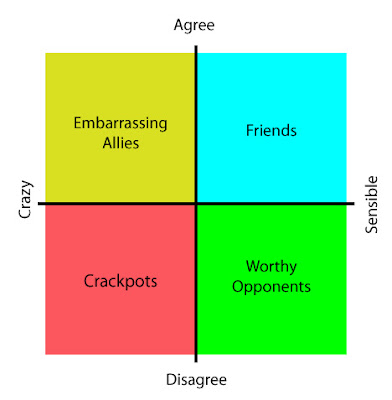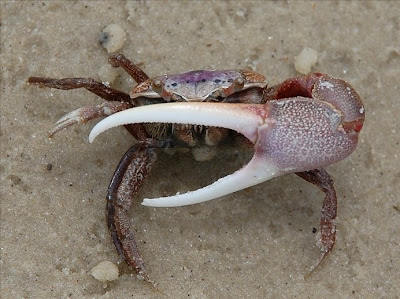
Bowerbirds are one of those fascinating species that you just have to love. The male constructs elaborate structures (bowers) to lure in females, going to great lengths to find just the right pieces. Some say that such structures are analogous to human artwork.
This new paper is the first to test an hypothesis that has been around for a few years that general cognitive ability may affect reproductive fitness. Kaegy and colleagues list a few ways that this could happen. Good cognitive skills may:
- Be indicative of good genes.
- Allow a parent to be a better provider.
- Allow one individual to trick another into mating (similar to an idea in this paper).
- Let one individual to attune courtship and mating behaviour to the desires of a wider variety of partners.
Curiously, in three of these four, they list the
male as being the one that benefits from good cognitive performance. Why enhanced cognition should be an advantage for males, but not females, in providing for offspring (say) is not at all clear.

They tested the bowerbirds’ problem solving ability by exploiting the birds’ colour preferences. Males
love having blue objects in their bowers, and they
hate having red objects in their bower. The team somewhat evilly conspired to place a bunch of red objects in males’ bowers... but made them rather difficult to remove.
In one case, they covered the red objects with a container. Birds had to removed the cover before they could get to the offending red bits. Males differed in how long it took them to solve this task, so there is variability that could be subject to selection. Males who solved the problem faster tended to have more mating success.
In the second test, the authors placed three tiles (one blue, one greed, one red) near the bower in a triangle. All were bolted down, so the bird literally could not remove them. The solution is not to take the red objects away, but to cover the red tiles with other materials. Here, the outcome is more complicated. The amount of red tile covered was
not correlated to mating success until some statistical jiggery-pokery is done to correct for the males’ age. The position of the red tile in the triangle was also having an influence. The amount the red tile was covered did correlate with mating success,
if the tile was in the position closest to the nest.
Somewhat strangely, getting a good score on the one test (clear covering) was not correlated with a good score on the second test (bolted objects). Again using some statistical procedures I am not really familiar with, the authors say when both results are considered, that problem solving correlates well with mating success.
The females didn’t see any of these males’ mental gymastics, as they rarely visited the bowers.
In this species, these results suggest that general cognitive skills are not due just to being a good provider, because since the males’ success was just in getting more copulations, not rearing offspring. It also seems unlikely that cognitive ability is being directly assessed by the females, since they weren’t around to see all this.
The discussion returns to a very strangely male-centric point of view. For instance, let me add some emphasis to this quote:
One prediction is that species with more intense sexual selection, such as polygynous species, should have enhanced cognitive abilities because of more intense selection for males with better cognitive performance.
It seems odd to argue that selection pressure on males specifically. Many of these hypotheses include the notion that females are constantly assessing males – and
assessment is a cognitive task, just like problem solving is. You have to remember, compare, and so on. (There are some sections of the paper that are a little more nuanced, but still.) If
New Scientist can be
chastised for its “geeks get the girls” line on this story, the authors could also do with a little egalitarian editing.
Media coverage
here and
here. I confess to being a bit disappointed because I had planned to blog about this before those articles came out, but I was too slow this time.
ReferenceKeagy, J., Savard, J., & Borgia, G. (2009). Male satin bowerbird problem-solving ability predicts mating success Animal Behaviour DOI: 10.1016/j.anbehav.2009.07.011Picture by user bdonald on
Flickr and used under a Creative Commons license.
 True, Texans should not be proud of their science standards. But at least Texas isn’t the butt of a joke in Futurama. If you missed it last night, the latest movie, Into the Wild Green Yonder, features a gag in the first bit about evolution.
True, Texans should not be proud of their science standards. But at least Texas isn’t the butt of a joke in Futurama. If you missed it last night, the latest movie, Into the Wild Green Yonder, features a gag in the first bit about evolution.
























